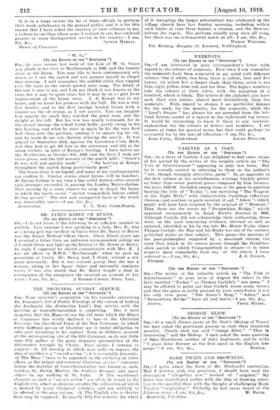THE PRINCIPAL SUNDAY SERVICE. [To THE EDITOR OF THE "
SPECTATOR."] SIR,—Your reviewer's association (in his remarks concerning Dr. Dearmer's Art of Public Worship) of the custom of making the Eucharist the distinctive Lord's Day service with the doctrine of transubstantiation is surprising. Has it been forgotten that the Mass—to use the old term which the House of Commons has wisely declined to ban—is the Christian Passover, the Sacrificial Feast of the New Covenant, in which every baptized person of whatever age is under obligation to take part according to his status? Even as children assisted at the corresponding rite of the Old Covenant, so do our little ones fitly gather at the great dramatic presentation of the deliverance wrought by Christ. Four points I venture to suggest : (1) .411 worship in which man seeks to express the idea of sacrifice is a "sacred action "; it is essentially dramatic. (2) The Maas " came to be regarded, to the exclusion of other cffices, as the unique and essential Christian service" centuries before the doctrine of transubstantiation was known as such, testibvs St. Justin Martyr, the Ordines Romani, and many
others—to say nothing of St. Luke. (3) The constituent elements of such a " sacred action" are all to be found in the English rite, albeit as disjecta membra the collocation of which is desired by many liturgical scholars, and not unlikely to be effected in the near future. (4) The English rite is shorter than may be supposed. In exactly fifty-five minutes the whole of it (excepting the longer exhortation) was celebrated in the village church here last Sunday morning, including within such limits of time three hymns, a sermon, and the Domine, saleum fay regent. The portions usually sung were all sung, but there was no instrumental music at all.—I am, Sir, &c., 1VanciN Wniatms. The Rectory, Drayton St. Leonard, Wallingford.


































 Previous page
Previous page